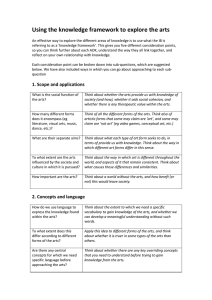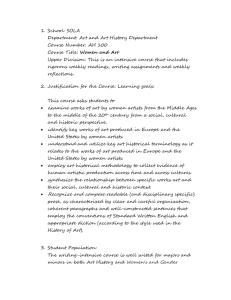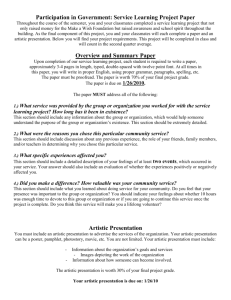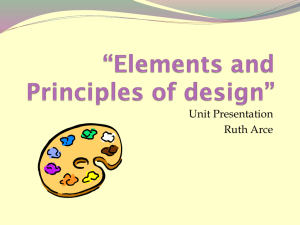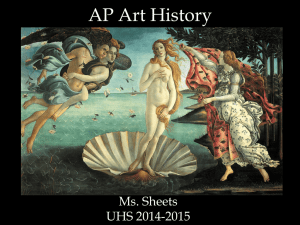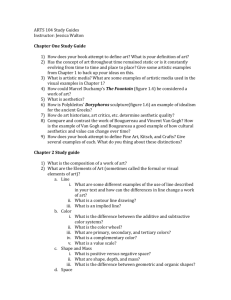art appreciation
advertisement
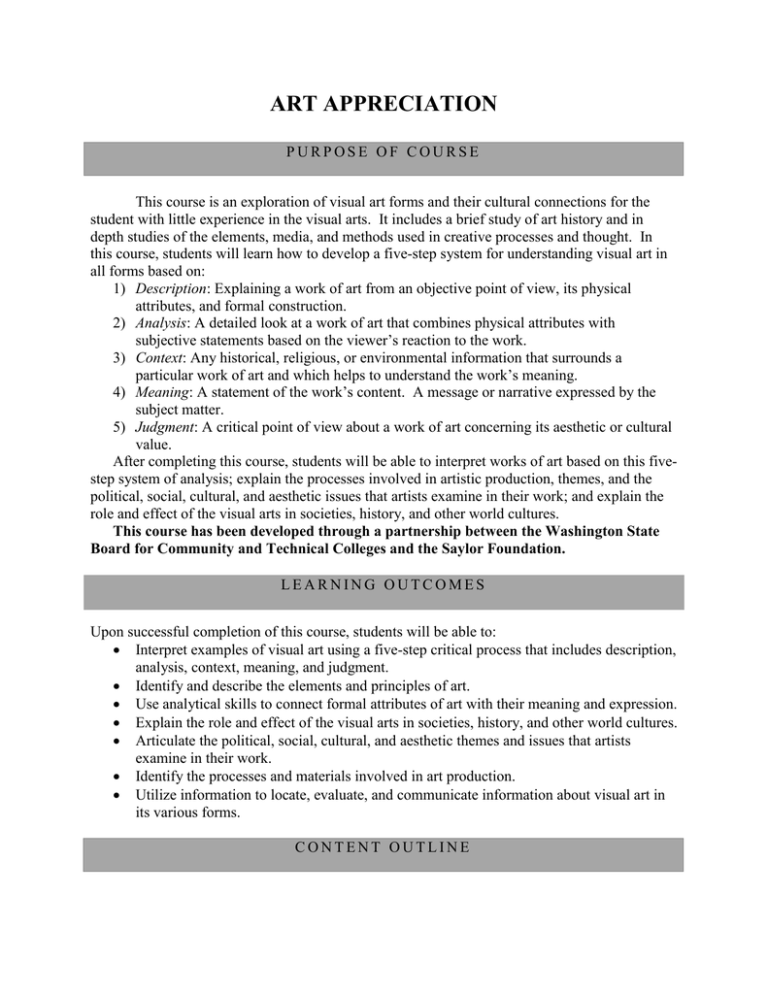
ART APPRECIATION PURPOSE OF COURSE This course is an exploration of visual art forms and their cultural connections for the student with little experience in the visual arts. It includes a brief study of art history and in depth studies of the elements, media, and methods used in creative processes and thought. In this course, students will learn how to develop a five-step system for understanding visual art in all forms based on: 1) Description: Explaining a work of art from an objective point of view, its physical attributes, and formal construction. 2) Analysis: A detailed look at a work of art that combines physical attributes with subjective statements based on the viewer’s reaction to the work. 3) Context: Any historical, religious, or environmental information that surrounds a particular work of art and which helps to understand the work’s meaning. 4) Meaning: A statement of the work’s content. A message or narrative expressed by the subject matter. 5) Judgment: A critical point of view about a work of art concerning its aesthetic or cultural value. After completing this course, students will be able to interpret works of art based on this fivestep system of analysis; explain the processes involved in artistic production, themes, and the political, social, cultural, and aesthetic issues that artists examine in their work; and explain the role and effect of the visual arts in societies, history, and other world cultures. This course has been developed through a partnership between the Washington State Board for Community and Technical Colleges and the Saylor Foundation. LEARNING OUTCOMES Upon successful completion of this course, students will be able to: Interpret examples of visual art using a five-step critical process that includes description, analysis, context, meaning, and judgment. Identify and describe the elements and principles of art. Use analytical skills to connect formal attributes of art with their meaning and expression. Explain the role and effect of the visual arts in societies, history, and other world cultures. Articulate the political, social, cultural, and aesthetic themes and issues that artists examine in their work. Identify the processes and materials involved in art production. Utilize information to locate, evaluate, and communicate information about visual art in its various forms. CONTENT OUTLINE UNIT 1: DEFINITIONS, ARTISTIC ROLES, AND VISUAL THINKING How would you define “art?” For many people, art is a specific thing: a painting, sculpture, or photograph, a dance, a poem, or a play. Art is uniquely human and tied directly to culture. As an expressive medium, it allows us to experience sublime joy, deep sorrow, confusion, and clarity. It gives voice to ideas and feelings, connects us to the past, reflects the present, and anticipates the future. Visual art is a rich and complex subject whose definition is in flux as the culture around it changes. This unit examines how art is defined and the different ways it functions in societies and cultures. Learning Outcomes Upon successful completion of this unit, the student will be able to: Define ‘art’ within a cultural perspective. Explain the difference between ‘objective’ and ‘subjective.’ Explain the different roles art plays within different cultures. Define the term ‘subject matter.’ Define the categories ‘realistic’, ‘abstract,’ and ‘non-objective.’ Recognize, evaluate, and describe artistic styles. Discuss the meaning of ‘aesthetics’ and its relationship to cultural conventions. Identify and discuss issues of visual awareness. 1.1 Form and Content 1.2 Aesthetics 1.3 Subjective and Objective Perspectives 1.4 Artistic Roles 1.4.1 Art and Ritual 1.4.2 Art and Commemoration 1.4.3 Art and Description 1.4.4 Art and Narrative 1.5 Artistic Categories 1.5.1 Fine Art 1.5.2 Popular Culture 1.5.3 Craft 1.6 Artistic Styles 1.6.1 Naturalistic 1.6.2 Abstract 1.6.3 Non-objective 1.7 Cultural Styles 1.8 Ideas of Perception and Visual Awareness UNIT 2: PROCESS AND TRAINING This unit explores the artistic process and the art industry surrounding it: from individual artists turning ideas into works of art to collaborative creative projects, public art, and the viewer. Learning Outcomes Upon successful completion of this unit, the student will be able to: Describe specific processes used by visual artists. Compare and contrast art as a social activity and a singular creative act. Identify and discuss historical forms of artistic training. Describe the cultural ties to artistic process and training. 2.1 The Artistic Process 2.2 The Individual Artist 2.3 Artistic Training Methods, Support Networks, and Cultural Considerations 2.4 The Role of Museums and Critics 2.5 Art as a Social Activity UNIT 3: HOW ART WORKS: THE ELEMENTS AND PRINCIPLES OF VISUAL LANGUANGE In this unit, you will begin to learn the terms that are used to describe and analyze any work of art and explore the principles of design—the means by which the elements in a work of art are arranged and orchestrated. Just as spoken language is based on fundamental letters, sounds, and grammar, visual art is based on elements and principles that, when used together, create works that communicate ideas and meaning to the viewer. We can refer to them as the building blocks of an artwork’s composition—the organized layout of an image or object, according to the principles of design. Learning Outcomes Upon successful completion of this unit, the student will be able to: Define and describe artistic elements and principles. Translate a realistic artwork into an abstract composition. Discuss compositional constructs and their effectiveness in the artistic process. Compare and contrast artworks from disparate cultures using the language of art. 3.1 Artistic Elements 3.1.1 The Point 3.1.2 Definitions and Qualities of the Line 3.1.3 Shapes: Positive, Negative, and Planar Issues 3.1.4 Figure/Ground Relationships 3.1.5 Mass 3.1.6 Space and Perspective 3.1.7 Value 3.1.8 Color: Its Qualities and Combination 3.1.9 Texture 3.2 The Principles of Design 3.2.1 Visual Balance 3.2.1.1 Symmetry 3.2.1.2 Asymmetry 3.2.1.3 Radial Balance 3.2.2 Repetition 3.2.3 Scale and Proportion 3.2.4 Emphasis 3.2.5 Time and Motion 3.2.6 Unity 3.2.7 Variety UNIT 4: HOW ART SPEAKS: FINDING MEANING Art, by its nature, asks questions and holds meaning. It explains ideas, uncovers truths, manifests what is beautiful, and tells stories. Up until now we have been looking at artworks through the most immediate of visual effects: what we see in front of our eyes. In this unit, we will begin to break down some barriers to find specific meaning in art, including those of different styles and cultures. Learning Outcomes Upon successful completion of this unit, the student will be able to: Explain the meaning of both form and content. Undertake comparative descriptions of form and content. Identify the three levels of meaning in works of art. Identify the use of iconography in art. Define the term ‘context,’ and discuss its essential role in finding meaning in art. Describe the role of the critic. Identify and describe the six critical perspectives. Identify, research, integrate, and explain visual information concerning artworks and specific meaning. 4.1 Introduction: Objective vs. Subjective Meaning 4.2 The First Level of Meaning: Form 4.3 The Second Level of Meaning: Subject 4.4 The Third Level of Meaning: Context 4.5 The Fourth Level of Meaning: Iconography 4.6 Critical Perspectives 4.6.1 Structural Criticism 4.6.2 Deconstructive Criticism 4.6.3 Formalist Criticism 4.6.4 Ideological Criticism 4.6.5 Psychoanalytic Criticism 4.6.6 Feminist Criticism UNIT 5: ARTISTIC MEDIA Artists find ways to express themselves with almost anything available. It is a stamp of their creativity to make extraordinary images and objects from various, but fairly ordinary, materials. From charcoal, paper, and thread to paint, ink, and found objects like leaves, artists continue to search for ways to construct and deliver their message. In this unit, we look at artworks created from two and three-dimensional media and arts made using different types of cameras. Learning Outcomes Upon successful completion of this unit, the student will be able to: Identify and describe specific characteristics of the mediums artists use. Investigate how time-based mediums affect issues of content. Explain and demonstrate how collage has a significant role in the development of Modern art. Explain how the advance of technology is reflected in the art historical record. Describe how cultural styles are influenced through the use of different artistic mediums. Explain the effect photography has on traditional artistic media. 5.1 Two-Dimensional Media 5.1.1 Drawing 5.1.1.1Dry Media 5.1.1.1.1 Graphite 5.1.1.2 Charcoals 5.1.1.3 Pastels 5.1.1.2 Wet Media 5.1.2 Painting 5.1.2.1 Encaustic 5.1.2.2 Tempera 5.1.2.3 Fresco 5.1.2.4 Acrylic 5.1.2.5 Oil 5.1.3 Printmaking 5.1.3.1 Relief Printing 5.1.3.1 Intaglio Printing 5.1.3.2 Planar Printing 5.1.4 Collage 5.2 The Camera Arts 5.2.1 Film Photography 5.2.2 Photography’s Impact on Traditional Media 5.2.3 Issues of Form and Content 5.2.4 Darkroom Processes 5.2.5 The Human Element 5.2.6 Color Images 5.2.6 Photojournalism 5.2.7 Modern Developments 5.2.8 Digital Photography 5.2.9 Time-based Mediums: Motion Pictures, Video, and Digital-streaming Images 5.3 Three-Dimensional Art 5.3.1 Definitions and Processes 5.3.2 Types of Sculpture and Other Three-Dimensional Media 5.3.2.1 Freestanding 5.3.2.2 Relief 5.3.3 Methods 5.3.3.1 Carving 5.3.3.2 Casting 5.3.3.3 Modeling 5.3.3.4 Construction/Assemblage 5.3.4 Modern Variations of Three-Dimensional Media 5.3.4.1 Installation Art 5.3.4.2 Performance Art UNIT 6: ARCHITECTURE This unit explores architecture, its history, and relation to visual art. Architecture is the art and science of designing structures and spaces for human use. Architectural design in itself is an art form realized through considerations of spatial design and aesthetics. Related to sculpture, architecture creates three-dimensional objects that occupy a given space and create a visual relationship with the area surrounding them. Learning Outcomes Upon successful completion of this unit, the student will be able to: Explain architecture’s significance to shelter and habitat. Describe the traditional and modern styles of architecture. Explain architectural materials and structural systems. Describe architecture as a reflection of culture. Identify and describe symbolic uses of architecture. Identify and describe new technologies and ‘green’ adaptations in architectural design. 6.1 What Is Architecture? 6.2 Traditional Methods and Materials 6.3 Architecture in China and the Far East 6.4 Cross-Cultural Influences 6.5 Architecture and the Industrial Revolution 6.6 Modern Architecture: A New Language 6.7 Post-Modern and Contemporary Architecture 6.8 Green Architecture UNIT 7: OUR WORLD: NATURE, THE BODY, IDENTITY, SEXUALITY, POLITICS, AND POWER In this unit, we will look at how artists express and interpret our world. If nothing else, visual art provides an avenue for self-expression. As a primary source, artists express attitudes, feelings, and sentiments about the world around us through personal experiences, social interaction, and our relationship with the natural world. In short, art gives us a perception of and a reaction to our place in the world. In Unit 1, we referred to description as one of many roles art affords us, but this description is often imbued with the artist’s subjective interpretation. In this unit, we will examine how art operates as a vehicle for human expression, a kind of collective visual metaphor that helps define who we are. Learning Outcomes Upon successful completion of this unit, the student will be able to: Define visual information as a source of knowledge. Describe how what we know is reflected in works of art. Explain and identify how artists use the natural world as a vessel for human experience. Explain how the use of animals as subject matter in art offer clues to cultural differences. Explore how art is a medium for self-identity. Explain the limits of representation of the body. Explore the idea of primordial couples and ties to human procreation. Describe sexuality in art seen through different cultural perspectives. Identify art as propaganda. Identify art as a vehicle of the state. Describe art and repression in societies. Explain art as a form of protest. 7.1 Identity 7.2 Self-Portraits 7.3 The Natural World 7.4 Social and Collaborative Art 7.5 Politics, Conflict, and War 7.6 Memorials 7.7 Peace UNIT 8: OTHER WORLDS: MORTALITY, THE SPIRIT, AND FANTASY Humans use art to capture the form of ideas about worlds outside of our own. Art is often a vehicle for myth or how we understand and explain concepts of a spirit world. Cultures use iconography to symbolize abstract ideas like dreams, love, power, and emotion, and cultures call on the artist to create them. Art also plays a significance role in ritual and ceremony. In this unit, we will see how art makes tangible things that inhabit the realm of human thoughts, beliefs, and imagination. Learning Outcomes Upon successful completion of this unit, the student will be able to: Identify art and ideas of the spirit. Describe how costume and decoration are used as vehicles for spirituality. Explain art as a form of myth. Describe the role of art in ritual and ceremony. Discuss connections among art, magic, and the idea of the fantastic. 9.1 Myths 9.2 Dreams 9.3 Spirituality 9.3.1 Christian 9.3.2 Islamic 9.3.3 Buddhist 9.3.4 African
